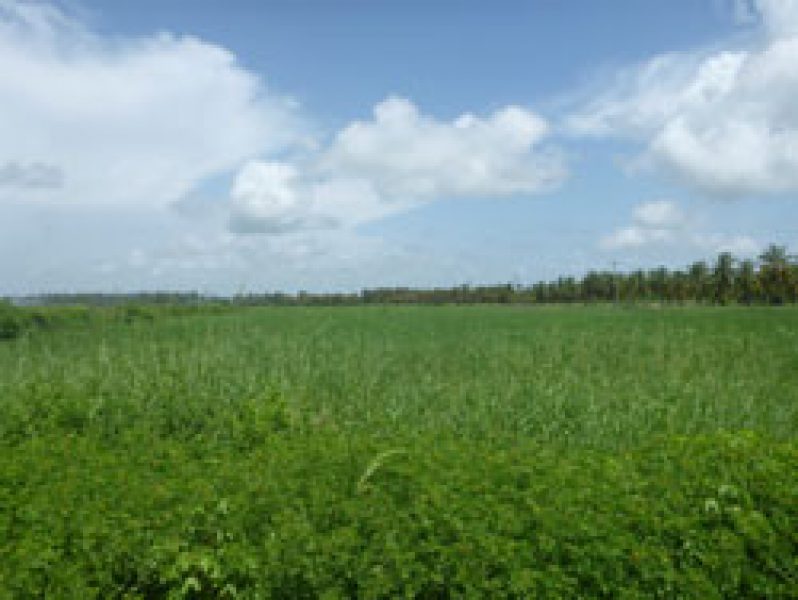-but RPA Head says prices will fall
GENERAL Secretary of the Guyana Rice Producers’ Association (RPA), Dharamkumar Seeraj yesterday confirmed that there are still approximately 100,000 tonnes of paddy from the last crop of 2013 still to be sold.
He said, “We can sell all the paddy tomorrow, but the farmers are holding out for better prices. We have 22 per cent of the crop still in the system, and harvesting of a new crop is scheduled to begin later this month.
“The reality is that the price for paddy will fall,” he said, and it is a fact that farmers would have to face,

Seeraj explained that farmers have become accustomed to selling most of their yields to Venezuela, which offers somewhat better prices than what obtains in other markets. However, he said, as efficiency and productivity improve in the rice sector, Venezuela will account for a smaller percentage of Guyana’s rice exports.
Seeraj said: “When we were producing just over 300,000 tonnes, Venezuela accounted for over 60 per cent of our exports. Now we have gone past that mark, with over 500,000 tonnes, of which only 30 per cent was exported to Venezuela. This means that 30 per cent of the exports attracted the best prices.”
Seeraj said that even when Guyana concludes a new agreement with Venezuela, which is expected to happen by the end of this week, the sector’s entire yield will not benefit from the prices offered by Venezuela.
He noted that Guyana is hoping to expand the current agreement with Venezuela, wherein 110,000 tonnes of white rice and 80,000 tonnes of paddy are supplied to Venezuela.
The RPA head maintained that the supply and demand dynamic presents a challenge for the industry, and is one that has the attention of major stakeholders. “It is an industry issue,” he said.
Seeraj added that this is where aggressive marketing efforts come in to secure new markets for Guyana’s rice. He said Guyana is looking to increase its market share in existing markets, as it simultaneously continues talks with new markets.
THREE-PRONGED APPROACH
In a prior interview with this publication, Agriculture Minister, Dr. Leslie Ramsammy had said that a three-pronged approach is being taken to increase exports in the sector:- increasing the market share in countries that have agreements with Guyana, re-entering old markets where the country once had a meaningful presence and securing new markets.
“I am currently talking to several countries,” he said, declining to name them as negotiations are still at an early stage.
Ramsammy added that efforts are underway to have Venezuela, Jamaica, Trinidad and Tobago, as well as countries in Europe review existing agreements for paddy and rice exports.
He explained that the Caribbean countries and Venezuela currently import rice from other countries besides Guyana, and there is an opportunity to secure greater shares in those existing markets.
On the matter of re-entering old markets, he said: “Countries like Cuba and Haiti used to account for exports of between 30,000 and 40,000 tonnes of rice. We had a meaningful presence in those markets.”
Ramsammy pointed out that, in the case of Haiti, since the earthquake that devastated that nation’s capital, much of the rice entering the country has been in the form of aid; but with the country in a position to purchase its own rice requirements, Guyana can take advantage of that market.
He added that, in 2006, Haitian national, Saj-Steven Angele Jeff Khauly began operating a mill, Saj Rice Mill in Region 5 (Mahaica/Berbice), under a 10-year lease and in an undertaking that facilitated trade to that country.
Earlier this year, the facility was upgraded, with new equipment and a new generator system, among other things; and the company has indicated its interest in extending its lease to 20 years.
“There are opportunities that we can take advantage of,” Minister Ramsammy said. Another area Guyana can make strides in to increase exports in the rice sector, according to the minister, is the promotion of private sector-to-private sector agreements.
“Getting the private sector itself connected with private sectors in other countries can boost our exports,” Ramsammy said.
He maintained that the consistent improvements in the sector are encouraging, and bode well for advances on different fronts.
The production target for the first crop of 2014 is 270,000 tonnes, and the RPA General Secretary expressed confidence that it could be met.
The production for 2013 was 535,212 tonnes, which is far above the original target of 413,000 tonnes, and reflects a 27 per cent increase over the production in 2012. The average production per hectare is five tonnes.
(By Vanessa Narine)














